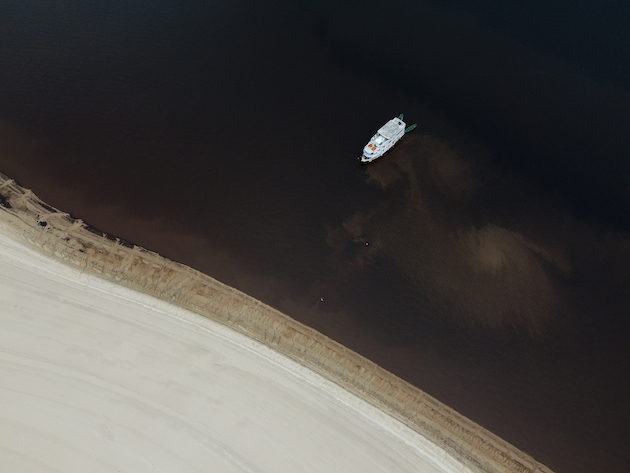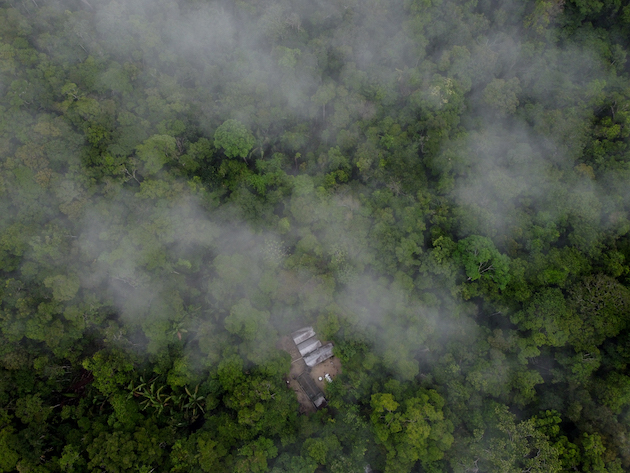
Indigenous leader and activist Vanda Witoto poses at her home in Manaus, Brazil, in October 2022. Credit: Michael Dantas/United Nations Foundation
By Farai Shawn Matiashe
BRASÍLIA, Oct 5 2023 – Raffaello Nava, a youth and student activist, has fled his home at the peak of the global Coronavirus pandemic after receiving death threats from multinational companies that invaded his ancestral lands in the Amazon rainforest.
The 22-year-old, whose name has been changed to protect his identity, is seeking refuge in Manaus, a gateway city to the Amazon tropical rainforest.
“They killed two of my friends. I had to run away,” he says while speaking in Portuguese through a translator.
The powerful companies are linked to former President Jair Bolsonaro. He was succeeded by 67-year-old Lula da Silva, a Latin American leftist and a veteran in Brazil’s politics who won in the October 2022 elections.
Nava’s tribe is resisting the invasions from these companies who are cutting down trees for timber and clearing land for agriculture.
“Our territory is wanted by these people. Cattle ranchers have already taken thousands of hectares. My people are receiving threats,” he says. “I am here on the frontline. Fighting to protect our land and that of Brazil, I do not even know if I will go back home or not. I fear for my life.”
Over the years, the lives of indigenous community activists and leaders have been at stake throughout the Amazon.
In 2020 alone, more than 260 human rights defenders were murdered in Latin America, 202 of which occurred in countries of the Amazon Basin, Colombia, Brazil, Peru, and Bolivia, representing 77 percent of the cases, according to a report by the Coordinator of Indigenous Organizations of the Amazon Basin (Coica).
About 69 percent of these murders in 2020 were against leaders working to defend territory, the environment, and the rights of indigenous peoples.

A boat on the shores of Rio Negro in Brazil. Credit: Michael Dantas/United Nations Foundation
Brazil holds 60 percent of the Amazon, the biggest tropical rainforest in the world, with the other portion shared by nine South American nations, including Peru and Colombia.
Brazil and Bolivia have about 90 percent of deforestation and degradation in the Amazon, shows data from research titled Amazonia Against the Clock, which covers nine countries sharing the tropical rainforest released in September last year by scientists from the Amazonian Network of Georeferenced Socio-environmental Information (RAISG) in collaboration with Coica.
Indigenous organisations from the Amazonas are calling for a global pact for the permanent protection of 80 percent of the Amazon forest by 2025.
In the Amazon, land grabbers have been invading the land of indigenous communities to pave the way for mining and agriculture.
Agriculture is responsible for 84 percent of deforestation in the Amazon forest, and the amount of land given over to farming has tripled since 1985, according to the report.
The Amazon forest plays a significant role in absorbing carbon dioxide from the atmosphere, thus reducing the effects of climate change caused by gas emissions worldwide.
There are over 390 billion trees in the Amazon, helping it to retain some 123 billion tons of carbon dioxide.
But over the years, increasing deforestation and land degradation have been reducing the ability of the Amazon forest to absorb carbon dioxide and instead contributing to global warming through both human-caused and natural fires.
The tropical rainforest has also been experiencing droughts and floods, signs human activities are causing climate change.
During his campaign days, Lula promised to combat deforestation in the Amazon forest, which had worsened under Bolsonaro, who was President since 2019.
Bolsonaro backed farm and ranching expansion in the region due to his links to some of Brazil’s powerful agricultural industry leaders.
Another activist based in Manaus, whose life is in danger from powerful people, says deforestation in the Amazon worsened under Bolsonaro.

An aerial view of a scientific research station, Camp 41, in the Amazon in Brazil. Credit: Michael Dantas/United Nations Foundation
“His policies are of less protection. He also reduced the number of protected areas in the Amazon. He made laws that should protect the forest weaker,” he says in an interview in Manaus in October 2022 during Brazil’s elections.
He says during Bolsonaro’s era, there was an increase in the loss of vegetation due to deforestation, reduced biodiversity and a rise in cases of invasions of indigenous communities in the Amazon.
The activist says agro-businesses and those in the extractive industries use pesticides and chemicals that pollute and contaminate water bodies in the Amazon forest, putting many people and animals in danger.
Vanda Witoto, a Brazilian indigenous leader, says multinational companies and agro-businesses were funding illegal operations such as logging in the Amazon during the Bolsonaro era.
“I visited some communities in the Amazon. There was illegal gold mining. Sadly, there is less reporting because the locals are being threatened. Big companies are investing a lot in illegal mining and deforestation in the southern part of the Amazon,” Witoto says, toning down her voice and holding back her tears during an interview at her home in the neighbourhood of Parque das Tribos just outside of Manaus in October last year.
“I saw this with my own eyes. Some indigenous people work for these companies, pushed by poverty and unemployment. We are against this. We have always been fighting to stop it.”
Adriano Karipuna, an indigenous leader, during an interview in October last year, said law enforcement agents in the Bolsonaro government were ineffective in arresting people committing crimes against his people.
“Our people have been struggling with deforestation. We have been reporting for the past years. But it worsened under Bolsonaro,” says Karipuna, who represents the Karipuna people, an indigenous group who have inhabited the Amazon rainforest for centuries.
“We have been receiving threats. Bolsonaro’s government has been taking our land and donating it to the invaders. Environmental criminals are going unpunished.”
Lula has just hit the ground running with his appointment of a veteran environmentalist, Marina Silva, as the Environment and Climate Change minister.
The 64-year-old Silva’s task is to rebuild Brazil’s environmental protection agencies and stanch the destruction of the Amazon rainforest.
Under Lula’s Presidency, Joenia Wapichana, the first-ever Indigenous woman elected to Brazil’s Congress, has been appointed leader of the country’s Indigenous affairs agency, the National Foundation of Indigenous Peoples, popularly known as Funai.
This is a huge achievement for the Brazilian indigenous communities whose role was suppressed under Bolsonaro.
Bolsonaro had to cut some of Funai’s budget, authority and number of staff, a move that crippled the agency when he assumed Presidency in 2019.
Witoto says she is hopeful that the predicament of indigenous people will change under Lula’s regime.
“We have to elect a person who respects the rights of indigenous people,” she says, speaking to IPS before Lula’s successful election. She added her people lived in fear from the violence perpetrated by Bolsonaro supporters for merely wearing Lula regalia during the election period in October.
A recent joint analysis by researchers at the University of Oxford, the International Institute for Applied System Analysis (IIASA) and the National Institute for Space Research (INPE) shows deforestation could fall by 89 percent by 2030 under Lula if he reinstates the policies introduced during his first term in office, saving 28,957 square miles of the Amazon rainforest.
Note: Reporting for this story was supported by the United Nations Foundation.
IPS UN Bureau Report